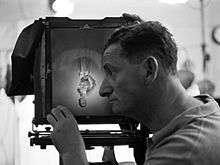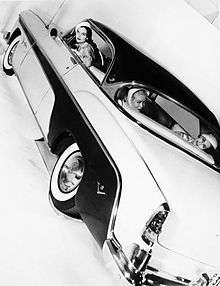Erwin Blumenfeld
Erwin Blumenfeld (26 January 1897 – 4 July 1969) was an American photographer of German origin. He was born in Berlin, and in 1941 emigrated to the United States, where he soon became a successful and well-paid fashion photographer, working as a free-lancer for Harper's Bazaar, Life and American Vogue. His personal photographic work showed the influence of Dadaism and Surrealism; his two main areas of interest were death and women. He was expert in laboratory work, and experimented with photographic techniques such as distortion, multiple exposure, photo-montage and solarisation.[1][2]
Erwin Blumenfeld | |
|---|---|
 Blumenfeld photographing Sophie Malgat, photographed by Gordon Parks, 1950 | |
| Born | 26 January 1897 Berlin, Germany |
| Died | 4 January 1969 (aged 71) Rome, Italy |
| Known for | Photography |

History
Blumenfeld was born in Berlin on 26 January 1897. As a young man he worked in the clothes trade and wrote poetry.[3] In 1918 he went to Amsterdam, where he came into contact with Paul Citroen and Georg Grosz.[1] In 1933 he made a photomontage showing Hitler as a skull with a swastika on its forehead; this image was later used in Allied propaganda material in 1943.[3]
He married Lena Citroen, with whom he had three children, in 1921.[4]:143 In 1922 he started a leather goods shop, which failed in 1935.[4]:143[3] He moved to Paris, where in 1936 he set up as a photographer[1] and did free-lance work for French Vogue.[3] After the outbreak of the Second World War he was placed in an internment camp; in 1941 he was able to emigrate to the United States.[1] There he soon became a successful and well-paid fashion photographer, and worked as a free-lancer for Harper's Bazaar, Life and American Vogue.[1]
Blumenfeld died in Rome on 4 July 1969.[1]
Publications
Blumenfeld started working on Blumenfeld: Meine 100 Besten Fotos in 1955; it was eventually published in 1979; an English translation, Blumenfeld: My One Hundred Best Photos, was published in New York in 1981. Another autobiographical work was published in German as Einbildungsroman by Eichborn Verlag in 1998, and in English as Eye to I: The Autobiography of a Photographer by Thames and Hudson in 1999.[1]
References
- Erika Billeter (2003). Blumenfeld, Erwin. Grove Art Online. Oxford: Oxford University Press. doi:10.1093/gao/9781884446054.article.T009382. (subscription required)
- Blumenfeld, Erwin. Benezit Dictionary of Artists. Oxford: Oxford University Press. doi:10.1093/benz/9780199773787.article.B00021202. (subscription required)
- Sarah James (2013). House of Dada. Frieze (9) (April–May 2013). Accessed February 2018.
- Anne Blecksmith (2006). Blumenfeld, Erwin. In: Lynne Warren (2006). Encyclopedia of Twentieth-Century Photography, volume 1. London; New York: Routledge. ISBN 9781135205430.
Additional sources
- Naylor, Colin, ed. (1988). "Erwin Blumenfeld". Contemporary Photographers (2nd ed.). Chicago: St. James Press. ISBN 0-912289-79-1.
- Eskildsen, Ute (2014). Erwin Blumenfeld. Photos, Drawings, and Montages. Jeu de Paume. New Haven, CT: Yale University Press. ISBN 978-0-300-19938-3.
- Blumenfeld, Erwin. "erwinblumenfeld.com".
- "Experiments in Advertising: The Films of Erwin Blumenfeld". ShowStudio.
- Watson, Nick (Director) (2013). The Man Who Shot Beautiful Women (Motion Picture). Remy Blumenfeld (Producer).